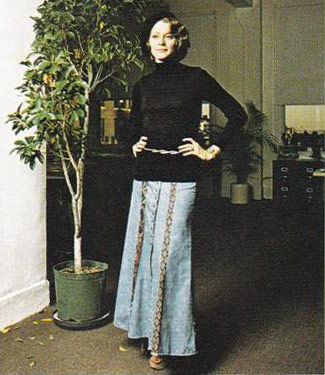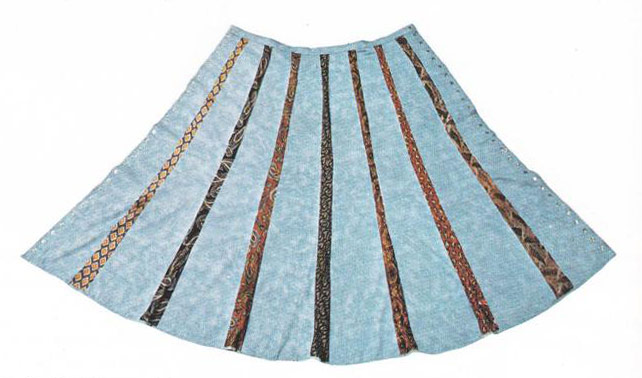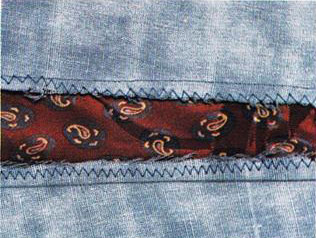Re-cycled Tie Skirt

Old ties become new fashion when sewn into an ankle-length denim skirt for all seasons.
One novel way to make use of old neckties is to make them a part of the fabric of a long skirt. The front-opening style of the skirt in the photograph is only one possibility. Ties might also be incorporated into an A-line skirt, a jumper, wide-legged trousers, or any home-made garment with simple lines. Buy a pattern for a garment and then follow the directions below for incorporating neckties into pattern sections.
The neckties are not used as is: rather, the back seam is opened, the interlining removed, and the ties pressed open to their full width. Then the tie is cut to the desired dimensions and shape (Figure B). A seam allowance of 6 mm is allowed for sewing the tie to the skirt fabric.

Figure B: The measurements given here include a 6mm seam allowance and are for ties used for the skirt pictured. Adjust the measurements to suit the garment you are making and your height. Then make a pattern and place it successively on top of each fully opened tie. Cut each tie along the cutting line. Measurements in centimetres.
First, make a paper pattern for the ties. Figure B below shows the dimensions of the pattern used to cut the tie for any garment. When adjusting the pattern to your height, it is preferable to trim off extra length from the top, so you make use of the wider part of the tie that extends to the hemline.
Equipment and materials
In addition to fabric and thread for the garment you are sewing, you need paper for making a pattern for the tie section, a pencil, pins, scissors, an iron, a sewing machine and, of course, an assortment of ties.
Cutting the ties
Remove the stitches from the back seam of each tie and take out the interlining and lining. Press the tie flat, using a damp cloth to avoid harming the delicate fabrics. Lay the pattern on the wrong side of each tie and cut along the cutting line.

12: Ties should be spaced at even intervals and arranged so the narrow sections are at the waist, the wider sections at the hemline.
Sewing ties to skirt fabric
Working from your skirt pattern, cut out the front and back pieces. The skirt will fit better if the major pattern sections are first cut out of the skirt fabric, and then each section is cut into wedge to accommodate the ties. Though this involved altering the tie pattern to cut proper-size skirt wedges and quite a bit of piecing, it is much easier in the long term to plan the placement of the ties on a full section of the skirt.
After you have cut out your skirt front and back, lay the ties on the fabric until you like the arrangement. Cut 1.2 cm off each side of the paper tie pattern. Working on the wrong side of the skirt sections, place this narrower
paper pattern where you want each tie to go and draw around it with a hard pencil to mark the cutting line. After marking all the wedges, cut the skirt fabric apart one wedge at a time, following the cutting lines.
Pin each tie to the skirt with right sides facing; then machine-sew the ties to the fabric. Each seam allowances should be 6 mm. After all the ties are sewn in place, finish the skirt as your pattern direct.
The skirt shown here has a self binding hem – a thin strip of material finishing the skirt’s bottom edge – instead of the usual turned-up hem. This is made with a 2.5 cm strip of fabric the length of the of the hem. To assemble such a strip, piece sections of the material cut on the bias until you have a strip of fabric the length of the hem, Place it on the skirt with right sides facing. Machine-sew the strip to the skirt, making a 6mm seam.
Now turn the free edges of the hem strip under 6mm and press it. Flip the strip to the underside of the skirt, pin it in place, and sew with a slipstitch. This hem gives the skirt an attractive edge and a professionally-finished look.

13. This is how the underside of the skirt looks with a tie strip sewn in. Press the seams towards the tie for a smoother fit.
Open Library

PROFILE
Open Library is an open, editable library catalog, building towards a web page for every book ever published.
Open Library is an initiative of the Internet Archive, a 501(c)(3) non-profit, building a digital library of Internet sites and other cultural artifacts in digital form. Other projects include the Wayback Machine, archive.org and archive-it.org
Books to Borrow
Books in this collection may be borrowed by logged in patrons. You may read the books online in your browser or, in some cases, download them into Adobe Digital Editions.
